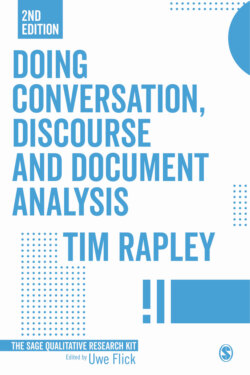Читать книгу Doing Conversation, Discourse and Document Analysis - Tim Rapley - Страница 7
На сайте Литреса книга снята с продажи.
About this Book and Its Second Edition
ОглавлениеUwe Flick
Analyzing discourse is currently one of the major approaches in qualitative research. Analyzing conversations has a long tradition in the history of qualitative research, as has the use of documents as data. In these approaches, data collection is often focused on creating a set of materials, by recording naturally occurring interactions, or selecting articles from newspapers or documents from institutional files, for example. In this process, the traditional methods of data collection, which produce the data especially for the research process – as is the case in interviews or focus groups – play a minor role. Here, it is rather the ways of making available and of making up the existing materials for research purposes that are decisive. Thus, steps like the transcription of audio or video materials and the generation of an archive are core steps in the research process and not just technical or even minor issues. Ethics become relevant in this context in a particular but also different way.
This book addresses these issues from the points of view of discourse analysis and conversation analysis. In doing so, it gives topics like transcription a different and perhaps even more systematic appraisal than in the other books in The SAGE Qualitative Research Kit. Nevertheless, it is supplemented by the other volumes in the Kit as well, as interviews and focus groups are special situations of conversation, which can be analyzed as such and not only for the contents that are communicated in them. Therefore, this book and the ones by Barbour (2018) on focus groups and Brinkmann and Kvale (2018) on interviews are complementary to each other.
The same can be said for the use of visual materials (Banks, 2018), which can also be used for studying discourses. Gibbs (2018), in his more general approach to data analysis, outlines ways of coding materials relevant for discourse and conversation analysis in more detail, especially concerning the use of computers and software. The same applies to the outline of Doing Grounded Theory (Flick, 2018a). The present volume is above all devoted to a single approach in the context of The SAGE Qualitative Research Kit, but at the same time it is well embedded in the more general scope of the Kit, as the approach can be used in combinations of methods (as in Doing Triangulation and Mixed Methods – Flick, 2018b). The more special considerations about quality and about the planning of analysis are an addition to the more general suggestions about designing qualitative research (Flick, 2018c) and managing quality in the process (Flick, 2018d). For its second edition, Doing Conversation, Discourse and Document Analysis has been updated throughout and extended, so that it also is linked to the new versions and new books in the new edition of The SAGE Qualitative Research Kit.
